Turn any article into a podcast. Upgrade now to start listening.
Premium Members can share articles with friends & family to bypass the paywall.
SAN FRANCISCO—On the sidewalk in front of a nondescript building on an unremarkable street in a nameless neighborhood one recent Tuesday afternoon, a small crowd begins queuing up. The array of aloha shirts and a large bouncer pleasantly chatting with those at the front of the line are the only indications that this is a tiki bar.
Besides a small placard on the door, there’s no outside signage to let the unsuspecting passerby know that behind the black-tinted windows lies an entirely different world, a place where a Polynesian aesthetic meets a Caribbean spirit and, shaken with ice, pours out as something weird and nostalgic and vibrant and escapist and entirely American. This is Smuggler’s Cove, a modern mecca for the tiki enthusiast and rum aficionado.
When the door opens a minute after 5 p.m., I step through into a narrow foyer, a liminal space where the sunlight behind me slips in and momentarily peeks through the curtain in front of me into the bar proper. Past this curtain, there is far less light—just dozens of accent lamps and lanterns—and my eyes need more than a moment to feast on the nautical decor. Wooden beams, rope nets and pulleys, barrels, a ship’s figurehead, and light fixtures shaped like pufferfish hang from the ceiling and walls in carefully curated chaos. In the corner above a staircase heading to the basement is a gigantic replica of a ship’s anchor suspended over a stone waterfall. The ceiling is covered in tapa, traditional cloth from the Pacific islands.
“It’s that transformative element,” Martin Cate, the owner of Smuggler’s Cove, told me a couple of hours earlier. “It’s that journey. You’re crossing a threshold.”
For the past 18 months, I’ve crossed a threshold myself into the world of tiki. I’ve gone from having the rare tropical drink on vacation and understanding tiki culture largely through Disney to buying formerly obscure cocktail ingredients like falernum and orgeat and searching online for inspiration to build my own at-home tiki bar.
My deep dive into tiki began when I first learned about Smuggler’s Cove from the award-winning book of the same name, written by Cate and his wife, Rebecca. The book has become a bible for anyone with an interest, from budding to fully blooming, in the strange but alluring world of tiki culture. A useful advertisement for the bar, Cate’s book also serves as a terrific introduction to the history, techniques, and entertaining basics of the tiki life. Since it was published in 2016, it’s remained among the best-selling books about cocktails and spirits on Amazon.
Indeed, I’m not alone. In casual conversations with colleagues or friends, I’ve learned there are aspiring tiki heads all around me—from craft cocktail enthusiasts to paraphernalia collectors. Some always remain casual fans, but others may quickly find themselves planning trips to destination tiki bars or even one of the dozens of annual tiki conventions.
The allure of tiki remains strong well into the second decade of what might be called the “tiki revival,” a rediscovery of this country’s tiki obsession from the post-World War II era that imprinted itself on countless parts of the culture, from cocktails to architecture. This revival is of a piece with the broader craft cocktail movement but also so much more, including the millennial generation’s embrace of the midcentury modern aesthetic and the increase in international travel by Americans over the past few decades. Since the COVID pandemic, the heightened interest in making cocktails at home has brought in new and younger converts to the tiki lifestyle. These days, you can find tiki bars in places as untropical as Tulsa, Minneapolis, and Cleveland. Your neighbor may be drawing up plans right now to transform his basement into a magical tiki oasis.
All of us are part of this loose community of Americans who, at various levels of commitment, have found something they’re looking for in tiki.
An antidote to now.
Back at Smuggler’s Cove, I sidle up to the bar on the main floor where my bartender, Danny Winans, makes me a Smuggler’s Rum Barrel, their signature take on the classic tiki cocktail. The recipe includes rum, various juices, and syrup, but neither Winans nor any of the other bartenders actually know the entire ingredient list (some of it is pre-batched). The finished product is beautiful to look at in a wide snifter glass, poured in such a way that the cocktail fills the bottom of the glass and the crushed ice sits on top, garnished with a mini-garden of mint leaves and a pink edible orchid. It’s a work of art, a mixological achievement. It’s also delicious.
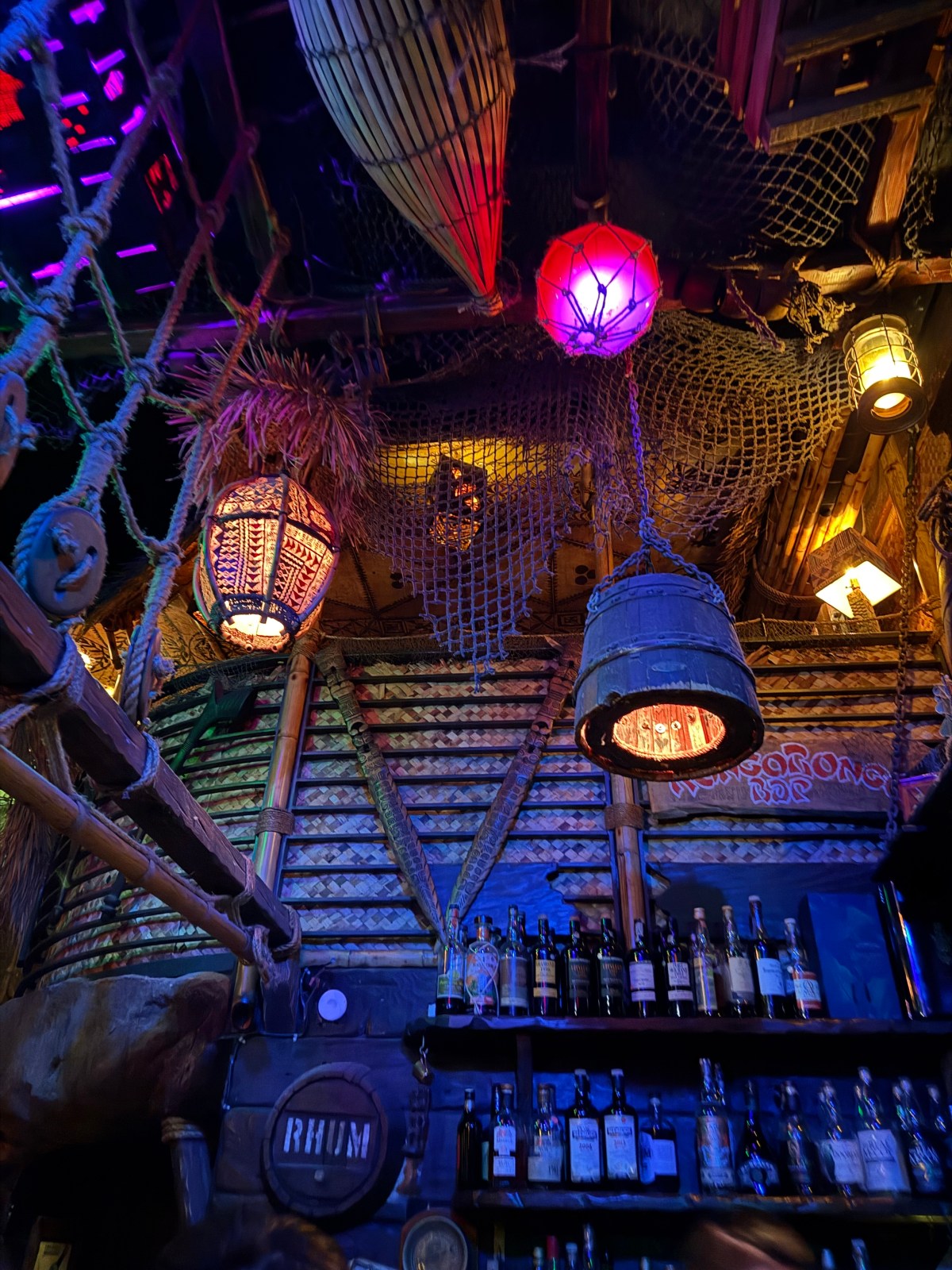
An elderly man sits down next to me and asks Winans to make him the same drink I have. He tells me his name is Greg and that he’s a lifelong San Francisco resident. His goal is to have a drink at every bar in the city, and he realized this place was on his way home and he’d never been in. “I saw it’s ‘Smuggler’s Cove,’ and I used to be a smuggler, so I thought, why not?” he tells me. I laugh and play along, asking him what he used to smuggle.
“Cocaine,” Greg deadpans. “Until I went to jail.” I have no idea whether to take him seriously. From behind the bar, Winans grins, shrugs, and brings me my second drink.
The Demerara Dry Float, Cate’s version of an original drink from tiki founding father Donn Beach, is a potent mix of lemon, lime, passion fruit, demerara syrup, cherry liqueur, and a good aged rum. A shot of overproof demerara rum comes on the side—“a side of danger!” Winans says—which you can methodically add as you drink the cocktail to appreciate how it changes the flavor. I end up dumping the whole thing on top and enjoying a full-force punch of rum that balances nicely with the tartness of the citrus and the sweetness of the syrup and cherry.
By now, the bar is full and lively. There are clearly regulars who know the bartenders or even Martin Cate, but also plenty of first-timers like the (ex-)smuggler Greg and me. What’s noticeable is that everyone is chatting, not looking at their phones or watching wall-mounted TVs (there aren’t any).
This is Cate’s fully realized vision for what a tiki bar, and a tiki experience, should be. San Francisco has more than a half dozen tiki bars, but Smuggler’s Cove may be the purest of the genre. Its drink menu is traditional but adventurous, its ambience is both mysterious and convivial, and there’s a sense of a shared encounter with something both fantastical and grounded. Smuggler’s Cove also operates as an unofficial museum of the great legacy of Bay Area tiki bars. Earlier that afternoon, Cate showed me the various relics he had grabbed from some of the Bay Area’s legendary but now lost tiki bars, including a “Boathouse” sign from the original Trader Vic’s location in Oakland and a tiki mug with a distinctive face from Tiki Bob’s in downtown San Francisco.
“There is something about tiki bars, particularly, that appeal to people’s sense of looking for something tactile and tangible,” Cate tells me as we chatted upstairs while the staff prepared for the evening. The artisanship surrounding us—carved weapons, woven bamboo—gets him going.
“This is real wood, this is real bamboo, this is real bac bac matting, this is real tapa cloth,” Cate says, moving his hand across the wall. “These are things that are all handmade. These are crafts. This is texture, natural, real artistry. This is hand-carved. All of this is an antidote to a digital life that is spent on a very two-dimensional screen in a digital space.”
The tiki tide washes in and goes out.
But let’s back up a bit to answer this: What is tiki culture? This would be a baffling question to anyone living in 1950s America, the equivalent to asking a fish what it means to be wet. Back then, tiki was simply the culture, or at least a significant part of it. It meant everything from exotic cocktails and Chinese American cuisine to the Polynesian pop aesthetic by which middle-class Americans decorated their homes with carvings and heads and art from the “South Seas.” Popular culture of the time is a window into Americans’ obsession with this part of the world in which many of its young veterans had just fought and won a war: James Michener’s Tales of the South Pacific (and the smash Rodgers and Hammerstein musical adaptation), Thor Heyerdahl’s Kon-Tiki expedition, and the popularity of Hawaiian and “exotica” music. To this day, the West Coast, particularly Southern California, is dotted with tiki-inspired building developments such as San Diego’s Shelter Island.
But at its core, tiki culture is about the drinks and the vibe (to use a modern term) surrounding them. And tiki revivalists obsess over its history. In the beginning there was Ernest Raymond Gantt, the itinerant Texan who traveled the tropical world picking up artifacts and stories and ideas. In 1933 Gantt, after the repeal of Prohibition, opened a bar in Los Angeles he ended up calling “Don the Beachcomber,” a pseudonym he had also adopted for himself. Gantt also eventually changed his legal name to Donn Beach (where the extra “n” came from is a mystery).
His was the first tiki bar, marrying an exotic tropical aesthetic with early Chinese American food and what would become known as tiki or tropical cocktails. Generally (but not always) employing Caribbean rum as a base spirit with fruit juice and sugars or syrups, Beach dressed these drinks up with outlandish garnishes, served them in eye-catching glasses and mugs, and gave them alluring names, like the Zombie and the Cobra’s Fang, that suggested fantasy and danger. The mixtures themselves had complex flavor profiles dictated by specific ratios of particular syrups, liqueurs, and even multiple rums—hallmarks that still define tiki cocktails. These drinks, and Beach’s bar, became popular with the Hollywood elite.
And here enters the other “founding father” of tiki, bartender and aspiring restaurateur Victor Bergeron. Brimming with ideas after visiting first Cuba and then Don the Beachcomber in Los Angeles, Bergeron returned to his bar in Oakland, California, determined to rebrand as his own version of what Beach had built in LA. This was now Trader Vic’s, and it was here that Bergeron developed the ur-tiki drink, the Mai Tai, as well as the most American faux-Chinese food favorite, crab rangoon. (Bergeron’s invention of the Mai Tai was always disputed by Beach, and the unresolved question keeps the debate alive in tiki bars more than 80 years later.)
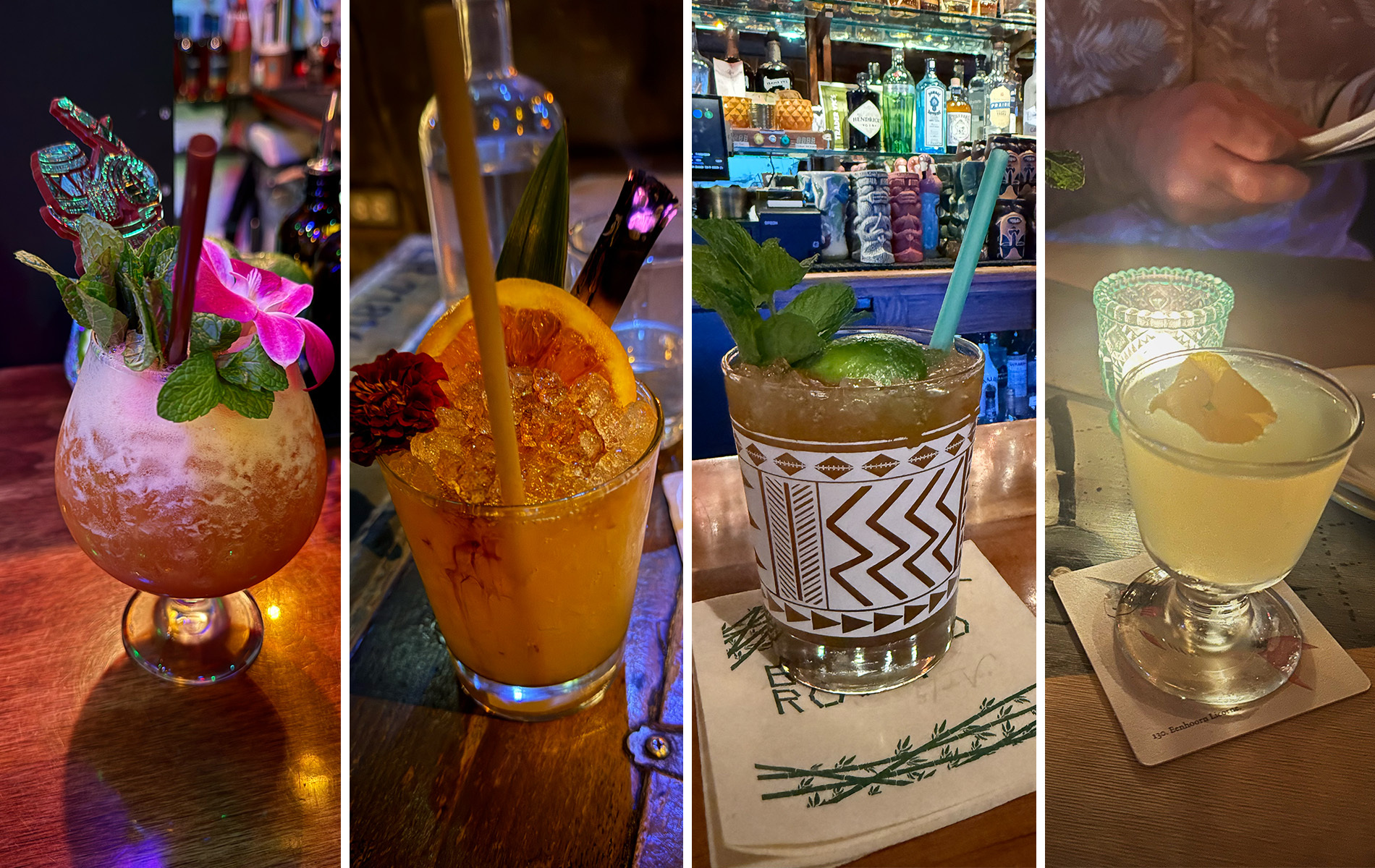
After World War II, both Beach’s and Bergeron’s empires expanded into chains, while countless imitators cropped up. Tiki bars could be found in every major American city and tiki cocktails became a staple for home bartenders. The tiki craze lasted into the early 1960s as Americans began vacationing in the new state of Hawaii and related trends like surfing blossomed.
But the decline of cocktail culture with the coming-of-age of the Baby Boomers brought a halt to tiki as well. What had been symbolic of the exciting future of American economic prosperity soon represented the passé and out-of-touch older generation, lost in a dated fantasy of having a good time. The zeitgeist of the new generation was to turn on, tune in, and drop out with something stronger than Planter’s Punch. By the 1990s, tiki seemed bound to be forgotten, maybe earning a paragraph in the history books like the flappers of the Roaring ‘20s.
But then came the tiki revival, brought to us by its twin godfathers, Sven Kirsten and Jeff “Beachbum” Berry.
In the mid-1990s Kirsten, a German-born film photographer living in Southern California, began photographing and documenting artifacts of the now-fading world of tiki in a practice he called “urban archaeology.” His The Book of Tiki published in 2000 and was the first to take the artistic style of tiki and Polynesian pop seriously. Around the same time, Berry, a bartender with a love for tiki, began a similar archaeological mission, this one for the lost recipes of Donn Beach, Vic Bergeron, and their imitators from the original tiki era. Through tenacious research and detective work, Berry found the original recipes from tiki bars across the country. He wrote a chapter in Kirsten’s The Book of Tiki and for nearly 30 years has written his own books with recipes for both classic and obscure tiki cocktails—most of which had never been published before.
The tiki revival has been going strong ever since, from a surge in new tiki bars in nearly every major American city to a renewed interest by home bartenders, particularly during and after the COVID pandemic. It got a boost from the broader cocktail renaissance, a movement to prioritize quality and technique in cocktail making.
Tiki goes east.
Tiki may be the most popular nearest to its origin in California, but there are no geographical limits to its laidback vibe—even in the epicenter of American hip-ness. Just ask Garret Richard, the bar manager at Sunken Harbor Club in Brooklyn. A Los Angeles native, Richard came to tiki not through his Southern California heritage or a particular interest in the drinks but by way of the music of the 1990s swing revival, a development parallel to the tiki renaissance.
“I was working in radio. I worked at a lounge station called Fabulous 690, which was owned by Clear Channel,” he told me one afternoon as we sat in the restaurant below Sunken Harbor Club. “They would play like you know, Sinatra, Dean Martin, but they would also play like Brian Setzer [and] Royal Crown Revue and all that kind stuff. So, yeah, so like that was all going on, and that kind of pushed me to look at Sven’s book.”
And Berry’s books, as well, particularly his 2007 Sippin’ Safari. Suddenly, Richard says, a whole new and exciting story of tiki and cocktails opened up to him. By this point, he was an underage college student at Fordham University in the Bronx, learning to make cocktails when most kids his age were just trying to make a decent cheap meal on a dorm-room hot plate. He began entering local cocktail competitions around New York even before he started working behind a bar. (Richard would eventually co-author his own book with the spirits writer Ben Schaffer, titled Tropical Standard, published in 2023.)
After school, Richard worked his way up in the city’s exploding craft cocktail bar scene, learning and honing experimental techniques and the science behind building balanced drinks. His interest in tropical drinks never waned but unlike in California, tiki and tropical drinks had only an underground following in New York. Tiki was reserved as an occasional special event night at a general bar, or maybe a sponsored temporary pop-up bar. Around 2015, Richard began working at Exotica, a tiki pop-up housed at the William Hotel in Midtown Manhattan. It was a way for Richard to tell the story he had been drinking in from Kirsten and Berry, not just about tiki drinks and decor, but the total customer experience.
“There was a performance aspect of it. I wanted to make sure the music was like a very important part of it,” Richard says, adding that they would have live lounge music and burlesque performances. “This sort of mid-century drinking and dining experience.”
All of this is on display today at Sunken Harbor Club, a first-come, first-served second-floor spot in downtown Brooklyn. The nautical-themed space has small tables and a short bar, contributing (along with the sailing-heavy decor) to the feeling that patrons are in a ship’s dining room. Richard has constructed a menu that reads like a book, dividing its cocktails by strength with a literary flair: “In the Shallows,” “The Twilight Zone,” and “The Abyss.”
“Like an old ‘30s or ‘40s menu,” Richard says. There’s more variety to the spirits here than at Smuggler’s Cove, which leans heavily toward rum, but here I stick to two of Richard’s versions on some classic rum-based tiki drinks: a Navy Grog variation called the Rhyme of the Ancient Mariner and a new twist on a classic Trader Vic’s concoction, Nelson’s Blood. (There’s a fourth drink section that would not have been on any original tiki bar menu, “On Dry Land,” for non-alcoholic drinks.)
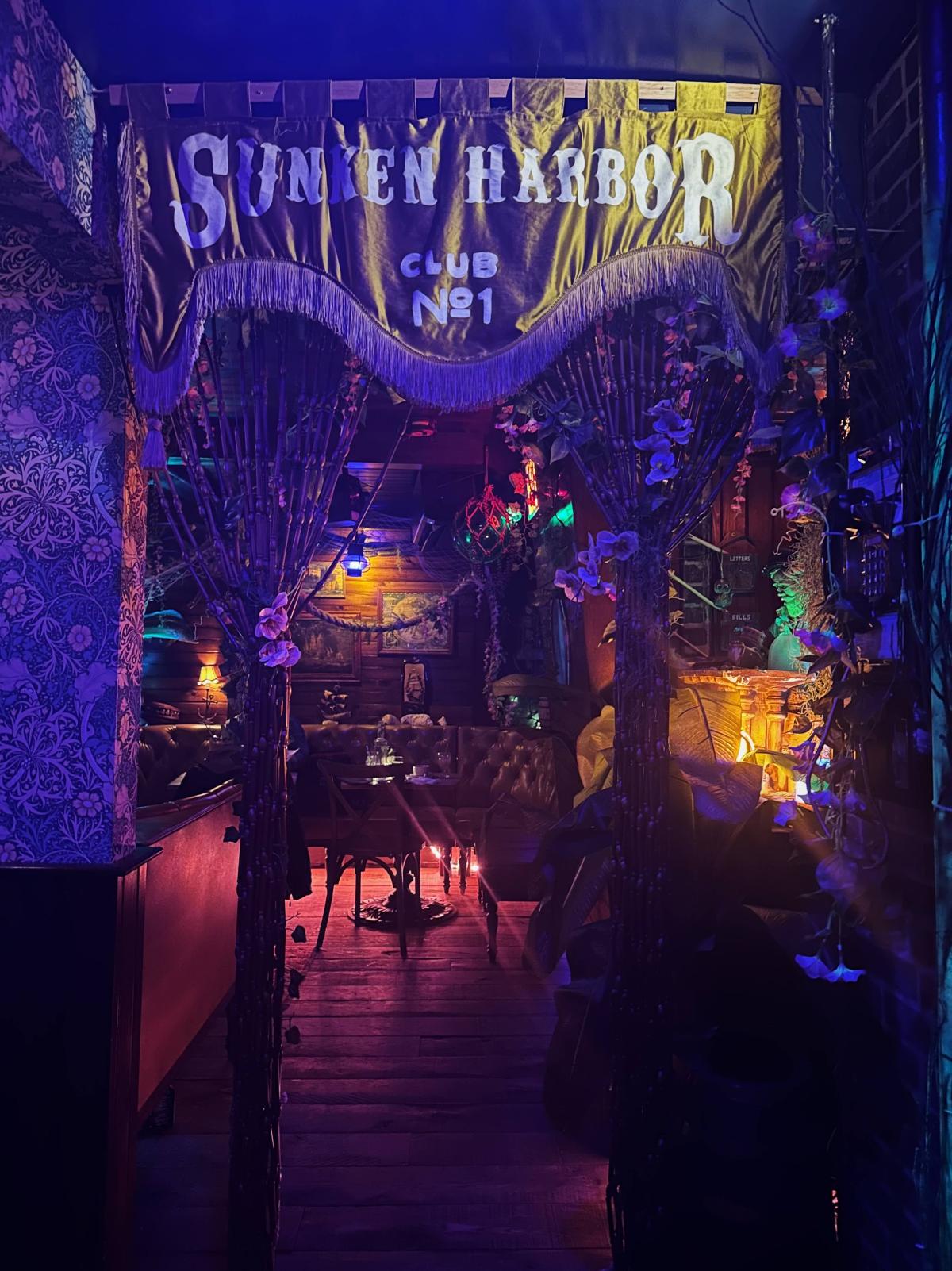
An evening at Sunken Harbor is a bit like an ongoing performance, from the ringing of the old bell behind the bar to “cast off” the ship at the beginning of the night to a “last call” where the lighting switches to red as everyone sinks into the abyss. Multiple times during my visit, waiters deliver the tequila-based El Diablo with a loud, head-turning shout of the drink’s name. By the third delivery, the rest of the patrons know the proper response is to yell right back, “El Diablo!”
“So much of it is about a performance, of being entertained as you drink and as you kind of take part in this experience,” Richard says.
There’s no place like home (for tiki).
For tiki-heads like Ian and Jennifer Schultz, part of the all-encompassing obsession with tiki is experiencing it at home. While they are fans and frequent patrons of tiki bars, they’ve also created their own in a bonus room in their house in Thousand Oaks, California. Shelves of tiki mugs encircle the room, with framed Hawaiian and other Polynesian-inspired art. Coffee bags and overhead mood lighting line the ceiling. A blue neon sign shines the name of their home bar, “Hale Inu Me Ka Inoa Ole,” Hawaiian for “the bar with no name.” Below that sign is a faux porthole with a screen that, when turned on, appears to house a school of fish.
“We’ve really invested a lot of time and effort and money in making this room into our little escape room,” Ian tells me as he and his wife sat at the bar he made himself.
“It’s not little,” Jennifer interjects. “It’s like a 400-square-foot room. It’s kind of ridiculous.”
Ridiculous? No, but it is impressive. A programmer for a social media company by day, Ian has coded a coordinated light-and-audio show that would fit right in at a commercial bar. His “thunderstorm” effect starts with the lights turning blue and the music on his speakers fading out as the sounds of rain roll in. When the storm is over, the blue lights fade out and the music comes back to regular volume.
“We’re both working normal jobs and, getting away from that, having a place where, you know, on Saturday night or Sunday night, we can watch a movie and be in here and hang out, have a cocktail, and have the cool mood lighting and everything,” Ian says. “It’s kind of fun.”

The Schultzes came to tiki through Ian’s brother-in-law, a well-known artist known as Tiki Tony. Ian, joined later by Jennifer, began helping Tony vend his wares at tiki get-togethers throughout Southern California and discovered how much bigger and varied the world of tiki enthusiasts can be. “There’s all these different vibes of tiki,” Ian says, from those interested in Hawaiiana to the connection to the rockabilly and hot rod subcultures to even the horror and macabre elements of tiki fandom.
Jennifer says that she and Ian prefer the traditional Polynesian pop that has inspired their home bar. But whatever your flavor of tiki, one hallmark is how it almost requires interpersonal reaction and real-life, meatspace experience.
“Tiki is kind of interesting in that it really exists in person,” Ian says. “It’s not an online thing as much.”
It’s the kind of hobby that begins with enjoying tiki mugs and cocktails and ends with you opening up your home to 50 strangers, as Ian and Jennifer did recently during a charity tiki crawl through Southern California to raise money for wildfire victims. Jennifer, the mixologist of the pair, served the “house” tropical cocktail she’s been working on for close to five years. It was a hit and even finally got a name suggested by one of the visiting bar crawlers: “The After Burner.”
“It’s a nice social interaction setting, because everyone’s in a really positive mindset when they do tiki stuff,” Ian says.
All American.
So what are we doing, getting into all of this tiki stuff? What is it that makes it so attractive, so inviting, so easy to fall into? Yes, it’s fun to put on a floral shirt and drink delicious concoctions out of a mug shaped like an Easter Island statue. There’s the escape from the monotony of modern life that stepping into a tiki bar provides and the nostalgia (or, in most cases these days, the “anemoia,” or longing for a time you’ve never actually experienced) for what the original tiki era could have been.
But more than that, tiki has all the makings of a vibrant subculture, the kind that thrives in a free society where individuals pursue their own happiness, and you get out of it exactly what you put in. Collectors can enjoy finding both vintage artifacts and new original craftwork while the fashion-conscious can indulge in floral clothing and jewelry. There are entry points for amateur mixologists who want to learn how to make great drinks at home, do-it-yourselfers who want to make their own home tiki bar, and gearheads who enjoy acquiring all the necessary tools, appliances, and ingredients.
In a word, it’s uniquely American—born not from any genuine folk tradition but of an audacious fabrication, an unnatural combination of cultural items and ideas that, together, creates something authentically inauthentic. Polynesian art plus Caribbean rum plus the American dream of escaping to somewhere warm, sunny, and carefree? It all equals tiki.
“It’s something crafted out of a very mainland American imagination, right, that is bringing all these elements together,” Cate tells me. “I mean, this may come off as highfalutin’ to say, but it’s jazz.”
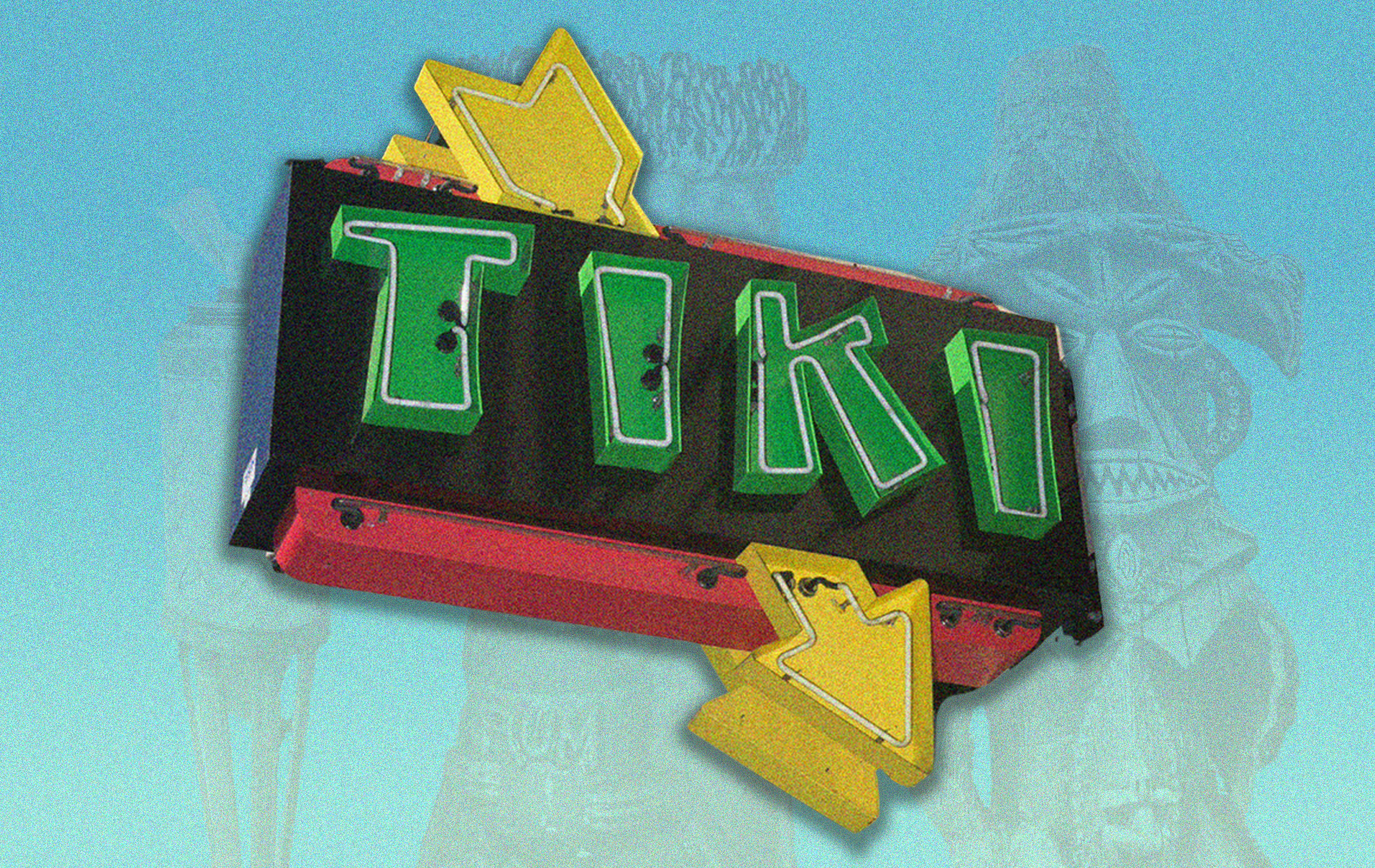


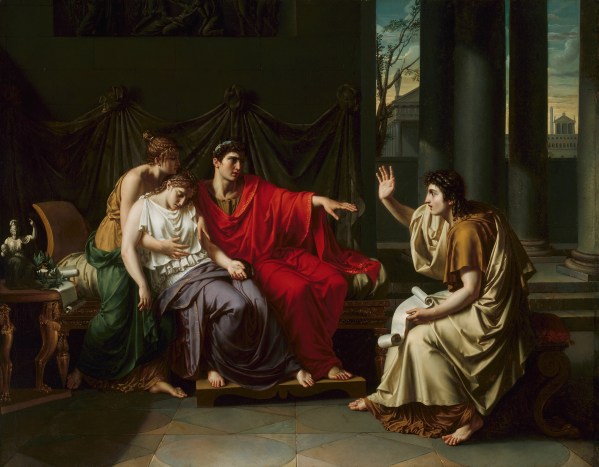


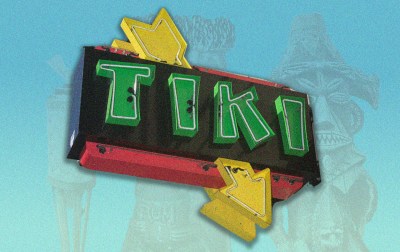
Please note that we at The Dispatch hold ourselves, our work, and our commenters to a higher standard than other places on the internet. We welcome comments that foster genuine debate or discussion—including comments critical of us or our work—but responses that include ad hominem attacks on fellow Dispatch members or are intended to stoke fear and anger may be moderated.
With your membership, you only have the ability to comment on The Morning Dispatch articles. Consider upgrading to join the conversation everywhere.